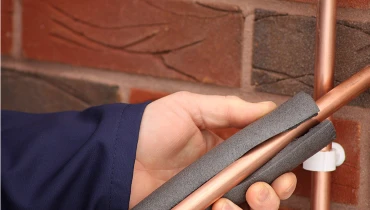Call This Monday to Get $50 Off
Schedule a Local Plumber in Morgantown Area - Call us Now to Get $35 OFF.
4.8 / 5 Ratings based on 794 reviews Great Plumbers, Great Reviews
Call This Monday to Get $50 Off
Schedule a Local Plumber in Morgantown Area - Call us Now to Get $35 OFF.

Winter is often romanticized as the time for cozy fires and hot cocoa, but for homeowners, it can also mean potential headaches like frozen and bursting water pipes. With a little preparation and the right knowledge, such winter woes can be avoided. At Mr. Rooter Plumbing, we provide reliable plumbing service for local clients including pipe repair. Our team enjoys helping our customers get the most from their pipes, and we want you to do the same. Here, we'll guide you on insulating your outdoor water pipes, a task that can save you energy, money, and unexpected cold-season stress.
A frozen pipe can burst, leading to costly repairs and water damage. By identifying which pipes need insulation, you're taking a proactive step toward protection.
Aside from preventing frozen pipes, insulation can reduce your energy bills and extend the lifespan of your plumbing by keeping the water at a stable temperature. Choosing the right insulation technique is important, some of the most popular methods include:
Foam sleeves are among the most straightforward and effective insulation methods available. Not only do these sleeves excel in energy efficiency by substantially minimizing heat loss, but their installation is also a breeze, even if you're not particularly handy with DIY projects. Foam sleeves offer an affordable solution, reducing the financial strain of what could otherwise be an expensive problem. When it comes to applying them, begin by measuring the length of the pipe you wish to insulate. Then, buy foam sleeves that fit the pipe's diameter. To install, simply open the sleeve's slit, wrap it securely around the pipe, and make sure consecutive sleeves are closely aligned without any gaps.
If foam sleeves aren’t ideal for you, consider opting for pipe-wrap insulation. Its prime advantage is its versatility; no matter the shape of your pipes, be it straight, curved, or with multiple joints, pipe-wrap can comfortably encase them. To apply, start by cleaning the pipe to ensure adherence. Begin the wrapping process from the bottom, progressing upwards. This technique helps avert any potential water buildup beneath the insulation. As you wrap, remember to overlap by at least half an inch for consistent coverage, and once you've covered the desired area, fix the end securely using tape.
While many prioritize insulating pipes, it's important not to overlook the outdoor faucets. Neglecting these gateways can be a costly oversight, as a frozen faucet might escalate to a frozen pipe. Faucet covers are a straightforward fix to potential freeze problems but are also remarkably easy to install. Begin the installation by shutting off the water supply to the faucet. Ensure the faucet area is devoid of any residual water drips by cleaning it thoroughly. Once ready, position the cover over the faucet, securing it tightly following the manufacturer's guidelines.
A well-insulated pipe system is just the beginning. Here are more tips to ensure you’re fully winter-ready.
Winter can be a challenging time for homeowners, but with adequate preparation, it doesn’t have to be. Properly insulating your outdoor water pipes is a simple yet effective way to avoid unnecessary stress and expenses. If you need help with winterizing, or if frozen water has caused pipe damage, then it’s important to hire a reliable plumber in your area. Call the team at Mr. Rooter Plumbing. Our friendly staff can help address your concerns and can schedule a convenient appointment with an experienced plumber for your next pipe repair or inspection service.
Why You Should Have a Tankless Water Heater Hot water is one…
Read More+Common Water Heater Problems and How to Fix Them Water heaters are…
Read More+Water in Your Shower Not Hot Enough? Everyone deserves a nice hot…
Read More+